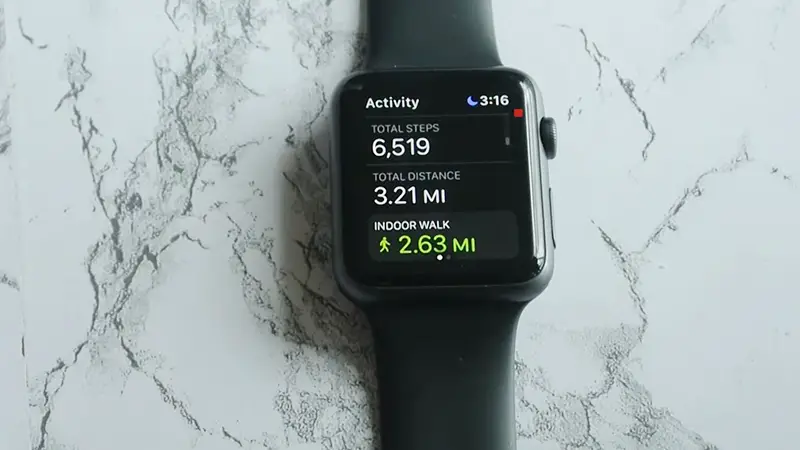Are you wondering how many steps you need to take each day to shed those extra pounds? You’re not alone.
The popular notion of clocking in 10,000 steps daily has been ingrained in our fitness culture, primarily because it’s a catchy, easy-to-remember goal. It’s also a challenge that’s achievable for most people.
However, the journey to weight loss isn’t as straightforward as counting steps. While walking 10,000 steps can help you burn approximately 300 to 400 calories, it’s essential to remember that to lose a pound a week, you need to burn an extra 500 calories a day.
So, lace up your walking shoes and let’s delve deeper into the science behind steps and weight loss.

Recommended Daily Steps for Good Health
Walking, in essence, plays a vital role in maintaining your physical health. However, the exact count of daily steps requires for optimal health tend to differ based on numerous factors. Let’s further unpack this.
The 10,000 Steps Per Day Myth
The popular health mantra of walking 10,000 steps a day originated from a Japanese pedometer company’s marketing campaign in the 1960s.
However, good health isn’t about reaching a set number of steps but involves regular moderate-intensity exercise.
The CDC recommends at least 150 minutes of this type of activity per week, equating to just over 7,000 steps daily. These are guidelines and individual health goals may require varying amounts of physical activity.
Average Steps Per Day in Different Age Groups
The number of steps one takes daily typically varies with age, with younger people generally being more active. However, individual progress is more important than comparisons between age groups.
Setting and achieving personalized step goals based on current fitness levels is key for a successful fitness journey.
Regardless of whether the aim is weight loss or maintaining a healthy lifestyle, it’s essential to work at one’s own pace and gradually increase activity intensity.
How to Calculate Your Daily Steps?

To calculate your daily steps, you can follow these steps:
Track your steps
Use an app or step counter to see how you’re progressing. You can use a pedometer, smartphone app, or fitness tracker to track your steps.
Establish a baseline
Walk for a week with your step counter or fitness tracker to establish your average daily step count. Make sure to take into account all types of walking, including leisurely strolls, expedited trips to the grocery store, and even when traversing your home.
Calculate your average
Take the total steps for the week and divide by seven to get your average daily step count.
Determine your goal
Based on your current fitness level and goals, determine the number of steps you want to aim for each day. If weight loss is your primary concern, you may want to aim for a daily deficit of 500 calories, which can be achieved by increasing your step count.
Incrementally increase your step count
Gradually increase your step count by 2,000 steps per day. For example, if your average daily step count is 5,000 steps, aim for 7,000 steps per day.
Monitor your progress
Keep track of your step count and assess the impact of your strategy. Consider how you’re feeling, as well as objective measures like weight loss or changes in blood pressure.
Stay active and make healthy choices
Combine your step count increment with other healthy habits, such as regular exercise and a balanced diet.
The Impact of Walking on Weight Loss
In the pursuit of weight loss, the potential of a physical activity as simple as walking often goes unnoticed. Underlying this simple action are complex biological processes that affect your weight loss journey.
Two key aspects contribute to the effectiveness of walking as a weight loss technique: its ability to burn calories and its influence on your metabolism.
Why Walking is Beneficial for Weight Loss?

Walking exemplifies the epitome of sustainable exercise – it’s gentle on your joints, accommodates your pace, and seamlessly integrates into any routine.
A consistent walking regimen, supported by a balanced diet and calorie deficit, offers a viable strategy for weight loss.
Walking not only burns calories but also counters sedentary lifestyle effects. For a path to weight loss, consider the words of Vasquez from the Women’s Health Magazine.
He reiterates that walking 10,000 steps alone doesn’t guarantee weight loss; it requires a holistic approach of controlled diet and resistance training.
Interestingly, the significance of walking extends further. According to a study published in the Medicine & Science in Sports & Exercise journal, an increase in pace, likened to brisk walking, results in burning more calories, leading to weight loss.
Remarkably, the study observed that runners weighed less than walkers, indicating that pace and speed influence the effectiveness of walking in the weight loss journey.
How Many Calories Burned Per Step?

The caloric calculation isn’t a one-size-fits-all formula. Each step you take burns calories, but the precise number varies owing to differences in weights, stride lengths, fitness levels, pace and inclines of different individuals.
On average, one could burn roughly 3-4 calories per 1000 steps, translating into 300-400 calories for 10,000 steps. However, keep in mind that it refers to a ballpark figure and might vary as per the mentioned variables.
To gauge a more personalized assessment of calorie burn, you can utilize the measurement called METs (metabolic equivalent). One MET quantifies the energy it takes to sit still. Vigorous intensity activities, including brisk walking, burn more METs.
The goal of walking 10,000 steps per day originated as it was catchy, easy to remember, and pushed most people beyond their average daily steps, ensuring a focus on general well-being along with caloric burn.
How Many Steps a Day for Weight Loss?

Given the previous discussions, it can be concluded that the exact number of steps ideal for weight loss tends to vary for each individual, influenced greatly by numerous personal factors.
Personal Factors to Consider
The optimal step count for weight loss is subjective and depends on various personal factors including age, metabolism, energy levels, body weight, and fitness capacity.
Metabolism affects the calories burned during walking; a faster one burns more calories. Heavier individuals also burn more calories while walking because their bodies work harder.
Conversely, fit individuals need fewer steps for weight loss due to their energy-efficient bodies. Additionally, lifestyle impacts the feasibility of reaching high step goals consistently, especially for those with sedentary jobs.
How to Set Realistic Daily Step Goals?
Setting daily step goals can aid in weight loss by creating a calorie deficit, but it’s important not to overeat as a result. Starting with an achievable goal and increasing it gradually is recommended for those who are currently inactive.
The standard 10,000 steps per day may not be necessary for everyone; research suggests that 8,000-10,000 steps can effectively aid weight loss by increasing calorie expenditure and controlling appetite.
Incorporating more movement into daily routines, like using stairs instead of elevators or parking further away can also help increase step counts.
Consistency is key in achieving these goals; smaller consistent targets often prove more effective over time than larger inconsistent ones.
Increasing Your Daily Step Count

As we’ve discussed, increasing your step count can be an effective strategy for weight loss. But how can you realistically achieve this is in day-to-day life? Let’s explore some tips and solutions to common problems.
Tips to Incorporate More Walking Into Your Day
- Opt for Walking, Whenever Possible: Design outings around walking. Start considering a walk to the store or incorporating a stroll on your lunch break.
- Utilize Technology: Fitness trackers encourage people to take 10,000 steps per day. A 2016 study, also concurs that 10,000 steps are ideal. It doesn’t hurt to use technology to your advantage if stepping up your fitness game is the goal.
- Try the Fifteen Minutes Three Times Daily Method: Here’s a discovery from a study on individuals over 60 years old: walking for 15 minutes three times a day after meals helps control blood sugar levels better than an extended 45-minute walk.
- Increase Your Step Goal Gradually: Don’t jump in all at once. If 10,000 steps sound overwhelming, start with a smaller number and work your way up.
Every additional step you take beyond your usual count contributes to weight loss. So, every bit matters.
- Dealing with Inconsistency: Don’t worry if you can’t meet your step goal every day. Consistency isn’t perfection, it’s about not giving up. Small fluctuations in your daily step count won’t derail your weight loss if you maintain an overall consistent routine.
- Fighting Sedentary Tendencies: It can be challenging to move more in a largely sedentary lifestyle, but there are ways around it. Stand while talking on the phone or do a quick walk during commercial breaks if watching TV.
- Avoiding Overeating: An intriguing observation comes from the University of Kentucky: when people burn calories with exercise, their bodies yearn for those calories back. Exercise enough to burn 1,500 calories a week, for instance, and you might eat about 1,000 extra calories. The key is to pair your increased activity with mindful eating.
Frequently Asked Questions
Why am I not losing weight despite walking 15,000 steps a day?
Despite walking significantly each day, you may not be burning enough calories to achieve a calorie deficit. It’s possible that the intensity or pace of your walk isn’t high enough to burn the calories necessary for weight loss.
Why haven’t I lost weight even after walking 10,000 steps daily?
Walking 10,000 steps daily is a useful guideline, but it’s not definitive. It’s crucial to consider your total calorie intake and ensure you’re maintaining a calorie deficit. If you’re consuming more calories than you’re burning, your walking routine may not result in noticeable weight loss.
How many steps should I walk daily to lose 2 pounds a week?
Aiming for a weight loss of 1 to 2 pounds per week is a healthy and sustainable approach. To reach this target, walking around 10,000 steps daily can help, as it burns approximately enough calories to shed a pound of fat in a week.
Has anyone successfully lost weight by walking 10,000 steps daily?
Yes, many people have reported successful weight loss from maintaining a routine of walking 10,000 steps daily. On average, this routine can yield a weight loss of 1-2 pounds per week, translating to around 4-8 pounds of weight loss in a month.
Conclusion
So there you have it. Forget the one-size-fits-all approach and tailor your step count to your unique needs. Remember, it’s not just about the numbers on your pedometer, but the consistency and intensity of your walks.
Pace yourself and utilize METs to gauge your calorie burn. Aim for a realistic 8,000 to 10,000 steps a day, but don’t stress if you fall short. It’s more important to make walking a regular part of your routine.
Use tech tools to your advantage and find creative ways to move more in your daily life. Stay patient, keep moving, and you’ll be on your way to sustainable weight loss. Now it’s time to lace up those sneakers and start stepping towards your weight loss goals.
I am a fitness instructor and I have been in the industry for 9 years. I have a passion for health and fitness.
I am a fitness instructor with over 9 years of experience in the industry. My passion is health and fitness and I would love to share my knowledge with you!